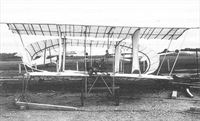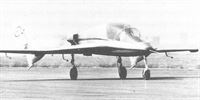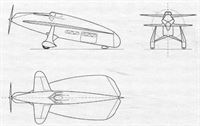Фотографии
-
Регистрационный номер: F-AZBP One of the two Breguet XIV replicas in flight. This one was configured as a mail plane of the famous ‘Lignes Aeriennes Latecoere’.
Самолёты на фотографии: Breguet Br.14 - Франция - 1916
-
Payen designed and built an Airspeed Horsa replica for the making of the movie ‘The Longest Day’.
Самолёты на фотографии: Airspeed Horsa / AS.51 - Великобритания - 1941
-
Payen greatly modified a Noorduyn UC-64 Norseman to make it look like a Latecoere Late-17.
Самолёты на фотографии: Latecoere L.14 / L.17 - Франция - 1924Noorduyn C-64 Norseman - Канада - 1935
-
Roland Payen built a replica of a Bleriot-Voisin biplane for a television series. This fragile aircraft is seen at La Ferte Alois in August 1973.
Самолёты на фотографии: Bleriot Bleriot-IV - Франция - 1906
-
Регистрационный номер: F-WGVA [6] The Payen Pa 49 ‘Katy’ as it appeared at Bretigny in 1976.
Самолёты на фотографии: Payen Pa.49 Katy / Pa.71 / Pa.149 - Франция - 1953
-
Регистрационный номер: F-WGVA [6] The Payen Pa.49 as it first appeared with its centreline undercarriage. The compact size left no room for a comfortable cockpit.
Самолёты на фотографии: Payen Pa.49 Katy / Pa.71 / Pa.149 - Франция - 1953
-
Регистрационный номер: F-WGVA [6] The Pa.49 Delta Jet on landing, after the undercarriage had been modified with a longer ground clearance. Note the size of the canopy, giving just enough room for the pilot’s head.
Самолёты на фотографии: Payen Pa.49 Katy / Pa.71 / Pa.149 - Франция - 1953
-
Регистрационный номер: F-WGVA [6] The Pa.49 Katy fitted with the belly fuel tank designed for the Italian demonstration tour which never took place. Note the ‘Flechair’ split rudder in open position and the absence of a canopy.
Самолёты на фотографии: Payen Pa.49 Katy / Pa.71 / Pa.149 - Франция - 1953
-
Регистрационный номер: F-WGVA [6] The Pa.49 on landing showing the first tricycle landing gear with short ground clearance.
Самолёты на фотографии: Payen Pa.49 Katy / Pa.71 / Pa.149 - Франция - 1953
-
Wind tunnel scale model of the Pa.49 with the ‘Flechair’ split rudder in open position.
Самолёты на фотографии: Payen Pa.49 Katy / Pa.71 / Pa.149 - Франция - 1953
-
Регистрационный номер: F-WGVA [6] The Payen Pa.49 installed in the full-size wind tunnel at Chalais-Meudon.
Самолёты на фотографии: Payen Pa.49 Katy / Pa.71 / Pa.149 - Франция - 1953
-
Payen Pa.49B ‘Katy’ (1953). One 265lbst(1.18kN) Turbomeca Palas. Span 16ft 10in (5.16m); length 16ft 9in (5.10m); height 7ft 5 1/2in (2.30m); wing area 123.8ff (11.50m2); empty weight 1,009lb (457kg); maximum take-off weight 1,428lb (647kg); cruising speed 200kts (370km/h); landing speed 54kts (100km/h); ceiling 26,245ft (8,000m).
Самолёты на фотографии: Payen Pa.49 Katy / Pa.71 / Pa.149 - Франция - 1953
-
Payen Pa.149 (1971). Two 330lb (1.47kN) Turbomeca Palas. Span 20ft 7 1/2in (6.3m); length 18ft 8in (5.7m); height 7ft 7in (2.35m); wing area 157ft2 (14.46m2); empty weight 1,035lb (474kg); maximum take-off weight 1,915lb (874kg); maximum speed 248kts (460km/h); cruising speed 189kts (350km/h); endurance two hours.
Самолёты на фотографии: Payen Pa.49 Katy / Pa.71 / Pa.149 - Франция - 1953
-
Payen Pa.71 Midget (1964). One 100hp (74.6kW) Continental O-200. Span 16ft 10in (5.15m); length 15ft 8in (4.75m); height 4ft 5in (1.35m); wing area 96ft2 (8.9m2); empty weight 505lb (230kg); maximum take-off weight 800lb (363kg); maximum speed 162kts (300km/h); endurance three hours.
Самолёты на фотографии: Payen Pa.49 Katy / Pa.71 / Pa.149 - Франция - 1953
-
The mock-up of the Pa.112 two-engine fighter was a derivative of the Pa.100. Underneath is the Pa.22 still under construction.
Самолёты на фотографии: Payen Pa.22 / Pa.112 Flechair - Франция - 1942
-
Payen Pa.22 - экспериментальный самолет, созданный для отработки концепции гоночного самолета Pa.112, разрабатывавшегося в конце 1930-х годов. На его базе предлагался вариант легкого истребителя.
The Pa.22/2 ‘Flechair’ wearing ‘Luftwaffe’ markings as ‘BI+XB’ in front of the Payen workshops.Самолёты на фотографии: Payen Pa.22 / Pa.112 Flechair - Франция - 1942
-
Payen-Melot Pa.22/1R (1935). One Melot ram-jet. Span 15ft 9in (4.8m); length 24ft 6 1/2in (7.485m); height 7ft 7in (2.35m); wing area 107.6ft2 (10m2).
Самолёты на фотографии: Payen Pa.22 / Pa.112 Flechair - Франция - 1942
-
Payen Pa.22S ‘Flechair Special’ (1942). Projected Pa.22 variant featuring retractable foreplanes.
Самолёты на фотографии: Payen Pa.22 / Pa.112 Flechair - Франция - 1942
-
Payen Pa.22 ‘Flechair’ (1935). One 180hp (134kW) Regnier R6. Span 15ft 9in (4.8m); length 24ft 6 1/2in (7.485m); height 7ft 7in (2.35m); wing area 107.6ft2 (10m2); empty weight 1,236lb (560kg); maximum take-off weight 2,108lb (955kg); maximum speed 275kts (510km/h); landing speed 65kts (120km/h); range 648 nm (1,200km).
Самолёты на фотографии: Payen Pa.22 / Pa.112 Flechair - Франция - 1942
-
Rear view of the Pa.101 with the tail hoisted into the air. “Which way is your ‘humbug’ flying?”, said Andre Herbemont when he saw the Payen racer for the first time.
Самолёты на фотографии: Payen Pa.100 - Франция - 1935
-
The sleek lines of the Payen racer were spoiled when the radial was installed. The aircraft is shown before the cowling was fitted. At that time, the wing was equipped with all-moving wingtips instead of ailerons.
Самолёты на фотографии: Payen Pa.100 - Франция - 1935
-
Pa.100 scale model showing the aircraft in its initial configuration, ie fitted with an in-line engine.
Самолёты на фотографии: Payen Pa.100 - Франция - 1935
-
The Pa.61F ‘Arbalete’ under construction at La Ferte Alais in May 1970. The aircraft has been readied for painting.
Самолёты на фотографии: Payen Pa.60 / Pa.61 Arbalette - Франция - 1965
-
A view of Payen’s workshop with three aircraft under construction, from left to right, the Pa.60 ‘Arbalete’, the Pa.Z10 ‘Guepard’ which was 80% built, and the ‘Aeracar’ flying car.
Самолёты на фотографии: Payen Pa.60 / Pa.61 Arbalette - Франция - 1965Payen Pa.65 Aeracar - Франция - 1965
-
Регистрационный номер: F-WSQA The Pa.61F ‘Arbalete’ in its final configuration sporting the test registration F-WSQA.
Самолёты на фотографии: Payen Pa.60 / Pa.61 Arbalette - Франция - 1965
-
Nicolas Roland Payen in 1976 besides the mock-up of the Pa.61 ‘Arbalete’.
Самолёты на фотографии: Payen Pa.60 / Pa.61 Arbalette - Франция - 1965
-
Sauvage-Payen SP.240 (1931). One 95hp (70.9kW) Salmson 7Ac. Cruising speed 108kts (200km/h); range 810mn (1,500km). Accommodation for one pilot and one stretcher.
Самолёты на фотографии: Sauvage-Payen SP.240 / SP.190 - Франция - 1931
-
Sauvage-Payen SP.190 (1932). One 400hp (298kW) Hispano-Suiza 8Fb or Gnome & Rhone 7Kdr Titan Major. Cruising speed 124kts (230km/h); range 810nm (1,500km). Accommodation for one pilot, one radio operator, one nurse, and six stretchers.
Самолёты на фотографии: Sauvage-Payen SP.240 / SP.190 - Франция - 1931
-
Регистрационный номер: F-W040 This rear view of the Aubrun-Payen AP-10 shows the shape of the wing. Elevators are hinged on the wing trailing edge. This aircraft, which spanned 16ft 3in (4.95m) and weighed 750lb (340kg), was test registered F-W040.
Самолёты на фотографии: Payen AP-10 - Франция - 1936
-
Payen P.350CD 'Coupe Deutsch de la Meurthe' (1938). One 150hp (112kW) Renault 4Pdi. Span 10ft 8 1/2in (3.3m), length 22ft 6 1/2in (6.87m), height 4ft 3 1/2in (1.35m), empty weight 640lb (290kg), loaded weight 1,060lb (480kg), maximum speed at sea level 270kts (500km/h), landing speed 46kt (85km/h).
Самолёты на фотографии: Payen P.350CD / P.200 - Франция - 1938
-
Payen P.200 (1938).
Самолёты на фотографии: Payen P.350CD / P.200 - Франция - 1938
-
Payen P.321AC1 Air Cruiser (1935). Four-engine (two Payen ‘Twins’), three-seat heavy fighter.
Самолёты на фотографии: Payen P.321AC / P.310CB / P.340TP / P.360TP - Франция - 1935
-
Payen P.310CB2 (1937). Two-seat fighter-bomber.
Самолёты на фотографии: Payen P.321AC / P.310CB / P.340TP / P.360TP - Франция - 1935
-
Payen P.360TP ‘Transport Public Transatlantique’ (1941). Span 31ft 6in (9.6m); length 36ft 1in (11.0m); height 10ft 6in (3.2m). Payen studied a variant of this aircraft fitted with liquid-cooled inline engines.
Самолёты на фотографии: Payen P.321AC / P.310CB / P.340TP / P.360TP - Франция - 1935
-
Payen P.340TP (1937).
Самолёты на фотографии: Payen P.321AC / P.310CB / P.340TP / P.360TP - Франция - 1935
-
Регистрационный номер: F-WFKY The sole Payen Pa.47 ‘Plein Air’ No.01 (F-WFKY) was registered to the ‘Societe Aero Routiere de la Loire’. This conventional touring monoplane spanned 30ft 9in (9.4m). Its length was 20ft 9in (6.35m) and its height 7ft 3in (2.2m).
Самолёты на фотографии: Payen Pa.47 Plein Air - Франция - 1949
-
Close-up of the twin-boom cargo plane wind tunnel model showing the double curvature flaps and the leading edge slots. This model was made out of a piano owing to the lack of good wood during the war.
Самолёты на фотографии: Payen Pa.65 Aeracar - Франция - 1965
-
Payen Pa.65 ‘Aeracar’ (1958). One 180hp (134kW) Lycoming.
Самолёты на фотографии: Payen Pa.65 Aeracar - Франция - 1965
-
Sketch showing the Pa.61 ‘Novae’ flying saucer project.
Самолёты на фотографии: Payen Pa.61 Novae - Франция - 1955
-
Scale model of the Pa.59 'Aldebaran'. This VTOL fighter spanned 17ft (5.2m) and weighed 2,454lb (1,112kg). It was intended to fly at 540kts (1,000km/h).
Самолёты на фотографии: Payen Pa.57 Aton / Pa.59 Aldebaran - Франция - 1954
-
Scale model of the Pa.57 ‘Aton’ two-seater trainer. Powered by two 883lb (3.9kN) Marbore jet engines, it could fly at 485kts (900km/h).
Самолёты на фотографии: Payen Pa.57 Aton / Pa.59 Aldebaran - Франция - 1954
-
The ‘Visair’ 1 microlight was Payen’s last aircraft to take to the air. It did not find a market and remained the only one of its kind.
Самолёты на фотографии: Payen Pa.152C Visair - Франция - 1984
Статьи
- Round-Out
- A.Pelletier - Paper Darts to Deltas
- A.Thomas - More from Mesopotamia
- A.Walg - Wings over the Steppes (3)
- B.Elliott - Bears in the Air
- B.Marshall - The 'Flea' and Me
- B.van der Klaauw - Fokker's American Heydays
- B.Walters - Nearly, but not Quite
- D.Henley - Singular Customer
- K.Wixey - Corpulent Feline (1)
- K.Wixey - 'Wild Catfish'
- M.Davey - Pacific Naval War
- M.Lopes - In at the Deep End









































